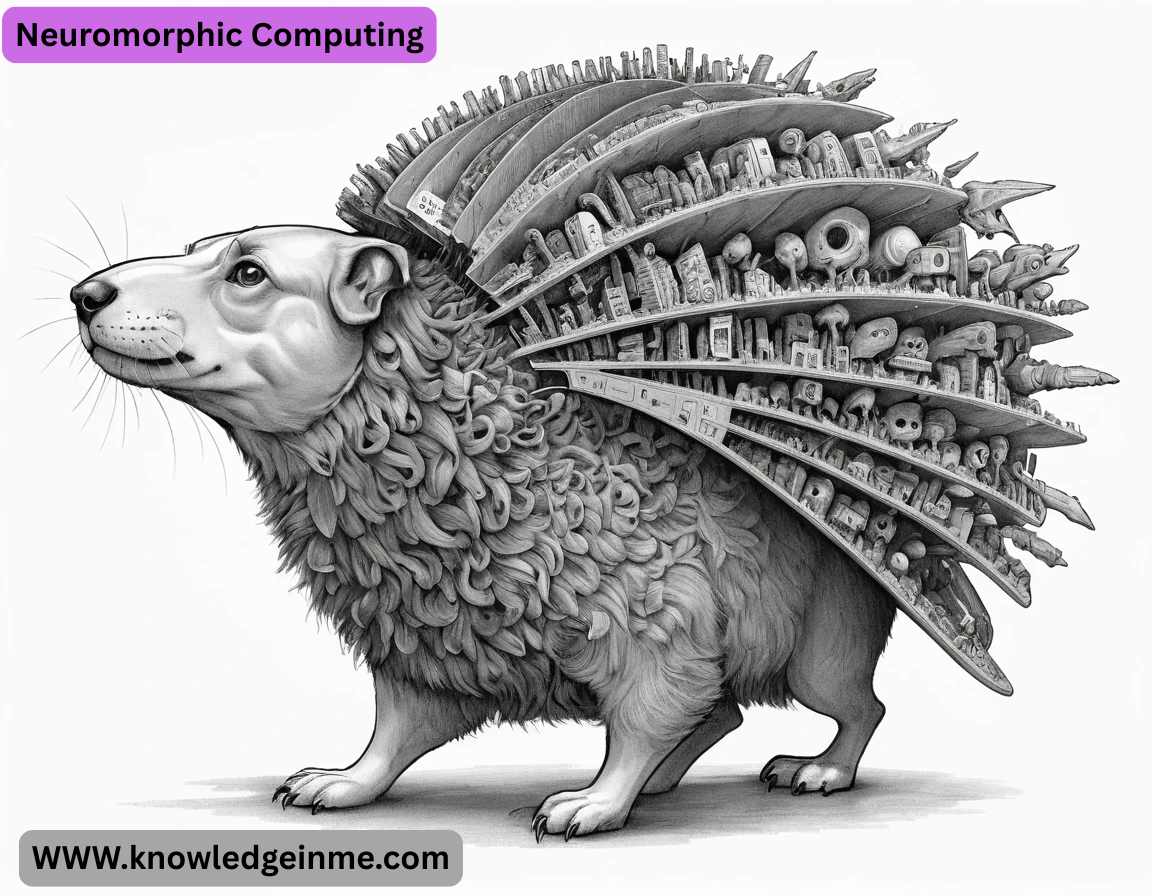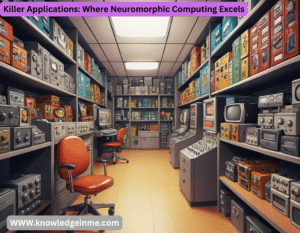Neuromorphic Computing Neuromorphic Computing is a cutting-edge approach to computing that draws inspiration from the structure and function of the human brain. Unlike traditional von Neumann architectures (used in most computers today), neuromorphic systems aim to mimic the brain’s neural networks to achieve high efficiency, parallelism, and adaptability.
Key Features of Neuromorphic Computing:
- Brain-Inspired Architecture:
- Uses artificial neurons and synapses to process information.
- Operates in a massively parallel manner, similar to biological brains.
Event-Driven (Spiking Neural Networks – SNNs):
- Unlike conventional artificial neural networks (ANNs), SNNs communicate via discrete “spikes” (like neurons in the brain).
- More energy-efficient since computation happens only when spikes occur.
Low Power Consumption:
- Neuromorphic chips (e.g., IBM’s True North, Intel’s LOIHI) consume far less power than traditional CPUs/GPUs for certain tasks.
Adaptability & Learning:
- Supports on-chip learning and real-time adaptation, making them suitable for AI and robotics.
Applications:
- AI & Machine Learning: Faster, more efficient deep learning with lower energy costs.
- Robotics: Enables real-time sensory processing and decision-making.
- Edge Computing: Ideal for IoT devices due to low power needs.
- Brain-Computer Interfaces (BCIs): Helps in modeling neural activity.
- Neuromorphic Sensors: Vision (e.g., event-based cameras) and auditory systems.
Challenges:
- Hardware Complexity: Designing efficient neuromorphic chips is difficult.
- Software & Algorithms: SNNs require new programming paradigms.
Leading Neuromorphic Chips:
- Intel Loihi (1 & 2): Research-focused, supports on-chip learning.
- IBM True North: Early neuromorphic chip with low-power operation.
- Brain Chip Akida: Commercial neuromorphic processor for edge AI.
- SPINNAKER (University of Manchester): Large-scale neuromorphic supercomputer.
Core Principles of Neuromorphic Computing
A. Spiking Neural Networks (SNNs)
- Unlike traditional artificial neural networks (ANNs), which use continuous activation values, SNNs communicate via discrete spikes (action potentials).
- Temporal coding: Information is encoded in spike timing, not just spike rates, enabling more efficient computation.
B. Synaptic Plasticity & Learning
- Spike-Timing-Dependent Plasticity (STDP): A biologically inspired learning rule where synaptic strength changes based on spike timing.
- Hebbian Learning: “Neurons that fire together, wire together.”
- On-chip learning: Some neuromorphic chips (e.g., Intel Loihi 2) support real-time adaptation without external training.
C. Event-Driven Computation
- Only active neurons consume power, unlike traditional processors that constantly poll for data.
- Asynchronous processing: No global clock; neurons fire when inputs reach a threshold.
2. Neuromorphic Hardware Architectures
A. Digital vs. Analog Implementation
Type Pros Cons Examples
Digital Precise, scalable, easy to program Higher power than analog Intel Loihi, SpiNNaker
Analog Ultra-low power, mimics biology better Noisy, hard to scale IBM TrueNorth (mixed-signal), BrainScaleS
B. Key Neuromorphic Chips
Chip Organization Key Features Use Cases
Intel Loihi 2 Intel Labs 1M neurons, on-chip learning, SNN support Robotics, edge AI
IBM TrueNorth IBM Research 1M neurons, ultra-low power (milliwatts) Cognitive computing
BrainChip Akida BrainChip Commercial SNN processor for edge devices IoT, vision, audio
SpiNNaker Univ. of Manchester Massively parallel ARM cores (1M+ CPUs) Neuroscience simulation
BrainScaleS Heidelberg Univ. Analog neuromorphic system, fast emulation Physics simulations
C. Memristor-Based Neuromorphic Systems
- Memristors (resistors with memory) can emulate synapses, enabling ultra-dense, low-power neuromorphic chips.
- Potential for in-memory computing, reducing data movement bottlenecks.
- Still in research (e.g., HP Labs, Knowm Inc.).
3. Software & Programming Models
- A. Challenges in Neuromorphic Software
- Simulation bottlenecks: Simulating large SNNs is computationally expensive.
- Training SNNs: Backpropagation doesn’t work well; alternatives include:
- STDP-based unsupervised learning
- Surrogate gradient methods (for backprop-like training)
B. Neuromorphic Software Tools
Tool Description Use Case
NEST Simulates large-scale SNNs Neuroscience research
Brian Python-based SNN simulator Prototyping SNNs
Lava (Intel) Open-source framework for Loihi Neuromorphic AI
SNNtorch PyTorch extension for SNNs Deep learning research
4. Applications & Future Directions
- Edge AI: Low-power, real-time processing for sensors (e.g., event cameras).
- Robotics: Fast, adaptive control without cloud dependency.
- Brain-Computer Interfaces (BCIs): Mimicking neural activity for prosthetics.
- Neuromorphic Sensors: Dynamic vision sensors (DVS), cochlear implants.
B. Future Challenges
- Scalability: Building brain-scale systems (human brain: ~86B neurons).
- Energy Efficiency: Pushing toward biological energy levels (~20W for the brain).
- Hybrid Computing: Combining neuromorphic + traditional AI for best performance.
C. Emerging Trends
- Quantum Neuromorphic Computing: Merging quantum computing with SNNs.
- Photonic Neuromorphic Chips: Using light instead of electrons for faster processing.
- Biohybrid Systems: Integrating real neurons with silicon chips.
- Biological Foundations: How the Brain Inspires Neuromorphic Systems
A. Key Neural Mechanisms Emulated in Hardware
Neurons & Spikes
- Neuromorphic chips use Leaky Integrate-and-Fire (LIF), Izhikevich, or Hodgkin-Huxley models for realism.
Synapses & Plasticity
- Short-term plasticity (STP) and long-term potentiation (LTP) are mimicked using memristors or digital circuits.
- STDP (Spike-Timing-Dependent Plasticity) is a key learning rule implemented in chips like Loihi.
B. Brain vs. Silicon: Efficiency Comparison
Metric Human Brain Best Neuromorphic Chip Traditional CPU/GPU
Power 20W ~ mW (TrueNorth) ~100W (AI training)
Speed ~5ms/spike ~µs-spike (Loihi 2) ~ns (but inefficient)
Parallelism ~100T synapses ~ 100M synapses (Loihi 2) Limited by memory
2. Neuromorphic Hardware: From Chips to Supercomputers
A. Digital Neuromorphic Chips (Clock-Driven)
Chip Neurons Synapses Key Innovation
Intel Loihi 2 1M 120M Programmable learning rules
SpiNNaker 2 10M (ARM cores) Massive parallelism for simulations
BrainChip Akida 80M (SNN) Commercial edge-AI deployment
B. Analog/Mixed-Signal Chips (Brain-Like Dynamics)
Chip Tech Key Feature
IBM True North 28nm CMOS 0.1W power for 1M neurons
BrainScaleS-2 Analog + FPGA 10,000x faster than biology
DYNAP-SEL (SYN Sense) Mixed-signal Low- latency sensor processing
C. Memristor & Emerging Technologies
- MEMRISTIVE Crossbars: Enable in-memory computing, avoiding von Neumann bottlenecks.
- KNOWIN, WEEBIT Nano working on commercial MEMERISTIVI neuromorphic systems.
- Photonic NEUROMOEPHICS: Light-based spikes for ultra-fast computing (e.g., MIT’s “LIGHTELLIGENCE”).
- Quantum Neuromorphic: Using qubits to simulate quantum neural networks (experimental).
3. Software & Algorithms: Training Spiking Neural Networks (SNNs)
A. SNN Training Methods
Method Pros Cons Used In
STDP (Unsupervised) Biologically plausible Slow convergence Loihi, BrainScaleS
Surrogate Gradients Backprop-compatible Approximated spikes Lava, snnTorch
ANN-to-SNN Conversion Reuse trained ANNs Loses temporal dynamics Edge deployments
4. Killer Applications: Where Neuromorphic Computing Excels
- A. Real-Time Edge AI
- Event Cameras + SNNs:
- Example: PROPHESEE’s neuromorphic vision (used in drones, cars).
- 100x lower power than traditional frame-based vision.
- Keyword Spotting (KWS):
- Brain Chip AKIDA enables always-on voice recognition at <1mW.
B. Robotics & Autonomous Systems
LOIHI 2 in Robots:
- Intel’s KAPOHE Point robot learns on-chip without a cloud.
Insect-Scale AI:
- Harvard’s ROBOBEE uses neuromorphic control for flight.
C. Neuroscience & Brain Simulation
- SPINNNKER simulates mouse-scale cortical networks (100M neurons).
- Brain SCALES models plasticity in real-time for research.
- D. Next-Gen AI Acceleration
- Hybrid AI: Combining SNNs + Transformers for efficiency.
Neuromorphic Supercomputers:
- Deep South (2024) will simulate 228 trillion synapses (~human brain).
5. Challenges & Future Frontiers
A. Key Roadblocks
- Scalability: Current chips are still 1000x smaller than a human brain.
- Programming Complexity: SNNs require new algorithms & tools.
- Noise & Variability: Analog chips suffer from manufacturing imperfections.
B. The Next 10 Years: Predictions
2025-2030:
- Memristor-based neuromorphics enter commercial AI chips.
- Hybrid ANN/SNN models dominate edge AI.
2030+:
- Brain-scale neuromorphic supercomputers (1B+ neurons).
- Quantum neuromorphic systems for ultra-fast learning.




